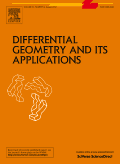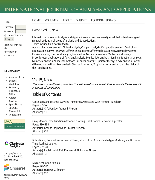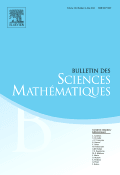
FRACTALS-COMPLEX GEOMETRY PATTERNS AND SCALING IN NATURE AND SOCIETY
Scope & Guideline
Illuminating the Patterns of Life: Where Geometry Meets Nature
Introduction
Aims and Scopes
- Fractal Geometry and Its Applications:
The journal explores the mathematical foundations and applications of fractal geometry, including its implications in natural phenomena, social systems, and engineering. - Fractional Calculus and Differential Equations:
A significant portion of the research involves fractional calculus, particularly in the context of modeling complex systems described by fractional differential equations. - Complex Systems and Network Theory:
Research often centers on the dynamics of complex systems, including fractal networks and their behavior under various conditions, contributing to advancements in understanding real-world phenomena. - Computational Modeling and Simulations:
The journal publishes studies involving numerical methods and computational techniques to solve fractal and fractional-order models, facilitating the analysis of complex systems. - Interdisciplinary Approaches:
It emphasizes interdisciplinary research, integrating insights from mathematics, physics, biology, and engineering to address complex problems using fractal and fractional methodologies.
Trending and Emerging
- Applications in Epidemiology:
An increasing number of papers utilize fractal models to understand the dynamics of infectious diseases, especially in the context of COVID-19, indicating a growing intersection between fractals and public health. - Machine Learning and AI Integration:
There is a notable trend towards incorporating machine learning and artificial intelligence techniques in fractal analysis and modeling, enhancing the capabilities of traditional approaches. - Environmental and Geophysical Applications:
Research focusing on the application of fractal models to environmental science, including fluid dynamics in porous media and geological formations, has gained momentum. - Complex Networks and Systems:
The exploration of fractals within the framework of complex networks, particularly in social and biological systems, is becoming increasingly prevalent, reflecting the interdisciplinary nature of current research. - Advanced Numerical Methods:
Emerging interest in sophisticated numerical techniques for solving fractal and fractional differential equations is evident, showcasing advancements in computational methodologies.
Declining or Waning
- Traditional Applications of Fractals:
There is a noticeable decrease in studies directly applying fractal geometry to classical fields such as art and architecture, as the focus shifts towards more complex, dynamic systems. - Basic Fractal Analysis:
Research that merely focuses on the basic properties of fractals, without deep computational or theoretical advancements, has seen reduced publication frequency, suggesting a move towards more innovative applications. - Static Models:
The trend indicates a waning interest in static models of fractal systems, as researchers increasingly favor dynamic and time-dependent models that capture the complexities of real-world behaviors.
Similar Journals

Communications in Analysis and Mechanics
Transforming ideas into impactful solutions in applied sciences.Communications in Analysis and Mechanics is a pioneering journal published by the AMER INST MATHEMATICAL SCIENCES (AIMS), dedicated to advancing the fields of mathematics, engineering, and applied sciences. With its recent transition to Open Access in 2023, the journal aims to enhance the dissemination of high-quality research by fostering a collaborative environment for researchers, professionals, and students. Operating from the United States, this journal embraces a broad scope encompassing geometry, optimization, and mechanics, ensuring a comprehensive platform for innovation and critical discourse. Despite its nascent status, it features competitive Scopus rankings in various disciplines, notably achieving a percentile around 7th to 13th, indicative of its growing impact among peers. The editorial team is committed to publishing original research that addresses significant challenges and developments within the mathematical sciences, facilitating a vital exchange of ideas and methodologies.

DIFFERENTIAL GEOMETRY AND ITS APPLICATIONS
Advancing Knowledge in Differential GeometryDIFFERENTIAL GEOMETRY AND ITS APPLICATIONS, published by Elsevier, is a premier academic journal primarily focused on the intricacies of differential geometry and its wide-ranging applications in various fields, including mathematics and theoretical physics. Established in 1991 and currently exploring relevant advancements through 2024, this journal serves as a vital platform for disseminating high-quality research that integrates theory and computational methodologies.With an ISSN of 0926-2245 and an E-ISSN of 1872-6984, it holds a significant position within the mathematical community, evidenced by its current quartile ranking of Q3 in major categories such as Analysis, Computational Theory and Mathematics, and Geometry and Topology. While open access options are not available, the journal's contributions are pivotal for researchers seeking to enrich their understanding of complex geometrical frameworks and their practical applications. As the landscape of differential geometry evolves, this journal stands out as a crucial resource for fostering innovation and collaboration among scholars and practitioners alike.

International Journal of Analysis and Applications
Connecting disciplines through applied mathematics and analysis.International Journal of Analysis and Applications, published by ETAMATHS PUBL, is a premier open-access journal dedicated to fostering advancements in the fields of analysis, applied mathematics, geometry, topology, and their applications in business and international management. With a commitment to providing high-quality research, the journal has been an open-access platform since 2013, ensuring that researchers, professionals, and students have unhindered access to valuable findings and methodologies. Based in Vancouver, Canada, the journal’s scope spans a diverse range of mathematical disciplines, bridging theoretical concepts with practical applications. The journal has been categorized in various quartiles as of 2023, reaching Q4 in Analysis and Applied Mathematics, and Q3 in Business and International Management, highlighting its growing importance in the academic community. At present, it is ranked 55th in Geometry and Topology and holds a respectable position within the Scopus database. By fostering innovative research and providing a collaborative platform, the International Journal of Analysis and Applications aims to contribute significantly to the development and application of mathematical theory in contemporary settings.

Journal of Fractal Geometry
Exploring the Infinite Complexity of FractalsWelcome to the Journal of Fractal Geometry, an esteemed publication in the fields of Applied Mathematics and Geometry, proudly published by the European Mathematical Society (EMS). With its open access model initiated in 2021, the journal ensures that groundbreaking research is readily available to scholars all around the globe. Since its inception, the journal has positioned itself as a vital platform for the dissemination of innovative research, focusing on the intricate study of fractal structures and their applications in various scientific domains. With an impressive H-index reflecting the journal's influence, it holds high rankings in respected databases, specifically ranking in the Q1 and Q2 quartiles for its authoritative contributions in applied mathematics as well as geometry and topology. Located in Berlin, Germany, the journal is dedicated to fostering a vibrant community of researchers, professionals, and students engaged in the beauty and complexity of fractals, making it an essential resource for advancing knowledge in this dynamic area of study.

Studia Universitatis Babes-Bolyai Mathematica
Cultivating Excellence in Mathematical ScholarshipStudia Universitatis Babes-Bolyai Mathematica is a prestigious journal published by UNIV BABES-BOLYAI in Romania, dedicated to advancing the field of mathematics and its diverse applications. With an ISSN of 0252-1938 and E-ISSN 2065-961X, this journal has carved out its niche in the Q3 category of miscellaneous mathematics as of 2023, ranking 315 out of 399 in the Scopus Mathematics General category, reflecting its commitment to quality and relevance in mathematical research. Covering a wide range of mathematical topics, it seeks to foster scholarly dialogue and innovation among researchers, practitioners, and students. Although it operates under a traditional access model, the journal remains a vital resource for the mathematical community, inviting submissions that contribute to theoretical advancements and practical applications. Established in 2016, Studia Universitatis Babes-Bolyai Mathematica is poised to remain a central platform for groundbreaking research through 2024 and beyond, making it an essential addition to the libraries of those engaged in mathematical study and discourse.

Fractal and Fractional
Elevating Research Standards in Fractals and BeyondFractal and Fractional is a prestigious open access journal published by MDPI since 2017, dedicated to advancing the study of fractals and fractional calculus, crucial fields that bridge mathematics, physics, and engineering. With an E-ISSN of 2504-3110 and based in Switzerland, this journal serves as a vital platform for disseminating cutting-edge research and innovative applications. As of 2023, it holds an impressive Q2 quartile ranking in multiple categories including Analysis, Statistical and Nonlinear Physics, and Statistics and Probability, placing it among the top tier of academic publications. Researchers will find valuable insights into contemporary issues within its scope, supported by robust metrics such as Scopus rankings which highlight its significant impact in the fields of Mathematics and Physics. Since its inception, Fractal and Fractional has garnered a reputation for quality and accessibility, making it an essential resource for academics and practitioners engaged in the exploration of complex systems and mathematical phenomena.

BULLETIN DES SCIENCES MATHEMATIQUES
Unveiling Pioneering Theories in MathematicsBULLETIN DES SCIENCES MATHEMATIQUES, published by Elsevier, is an esteemed journal dedicated to the field of mathematics, particularly excelling in miscellaneous mathematical disciplines. With an impressive Q1 category quartile ranking in 2023, it positions itself among the top tier of journals in its field, reflecting its commitment to high-quality research and scholarship. The journal operates under the ISSN 0007-4497 and E-ISSN 1952-4773, facilitating a robust platform for sharing pioneering mathematical theories and applications. Researchers, professionals, and students will find invaluable insights and comprehensive studies here, aiding in the advancement of mathematical knowledge and fostering collaboration across disciplines. The journal's comprehensive scope includes a broad range of topics, ensuring it remains at the forefront of mathematical research until its convergence in 2024. Whether you are seeking to publish groundbreaking findings or to stay updated with the latest advancements in mathematics, the BULLETIN DES SCIENCES MATHEMATIQUES is a definitive resource for the academic community.

Periodica Mathematica Hungarica
Elevating Research Standards in Mathematical Studies.Periodica Mathematica Hungarica is a prestigious academic journal published by Springer, focusing on the field of mathematics, with a particular emphasis on miscellaneous mathematical studies. Established in 1971, this journal has maintained its commitment to advancing mathematical research and its applications, making significant contributions over its converged years through 2024. With a Q2 ranking in the mathematics category as of 2023, it establishes itself as a vital resource within the mathematical community. Researchers and academics will find its inclusion in the Scopus database, ranking #189 out of 399 in general mathematics, indicative of its impact and relevance. Although it does not feature open access, the journal provides a wealth of high-quality peer-reviewed articles, thereby serving as an essential platform for the dissemination of innovative mathematical theories, methodologies, and findings. Engaging with the content of Periodica Mathematica Hungarica is crucial for anyone looking to stay at the forefront of mathematical research and development.

Jordan Journal of Mathematics and Statistics
Empowering Research in Mathematics and Statistics.The Jordan Journal of Mathematics and Statistics, published by Yarmouk University, Deanship of Research & Graduate Studies, serves as a pivotal platform for researchers and scholars in the fields of Mathematics and Statistics. With the ISSN 2075-7905 and E-ISSN 2227-5487, the journal seeks to disseminate original research findings and innovative methodologies across various branches of Applied Mathematics, Statistics, and related disciplines. Despite its Q4 categorization in the 2023 Scopus rankings, it bolsters a keen interest to enrich the academic community's understanding of contemporary statistical challenges, fostering an inclusive environment for idea exchange. The journal encourages submissions that promote theoretical advancements as well as practical applications, thus appealing to a diverse audience. Researchers, educators, and students seeking to stay abreast of current trends in mathematics and statistics will find this journal an invaluable resource in Jordan and beyond.

Advances in Difference Equations
Fostering Collaboration in Mathematical ResearchAdvances in Difference Equations is a prestigious journal published by SPRINGER, catering to researchers and practitioners in the fields of mathematics and applied sciences. With an ISSN of 1687-1847 and an outstanding reputation, this Open Access journal has been disseminating high-quality research since 2004. It plays a crucial role in advancing the understanding of difference equations, covering a wide range of topics that intersect with algebra, analysis, and applied mathematics. Recognized for its impact, the journal's quartile rankings in Q1 for Algebra and Number Theory, and Q2 for both Analysis and Applied Mathematics in 2023, reflect its esteemed position in the academic community. The Scopus rankings further emphasize its significance, placing it in the top percentiles across multiple categories. By providing unrestricted access to innovative research, Advances in Difference Equations is essential for fostering collaboration and knowledge transfer among scholars, and ensuring the latest findings are readily available to those who seek to push the boundaries of mathematical inquiry.